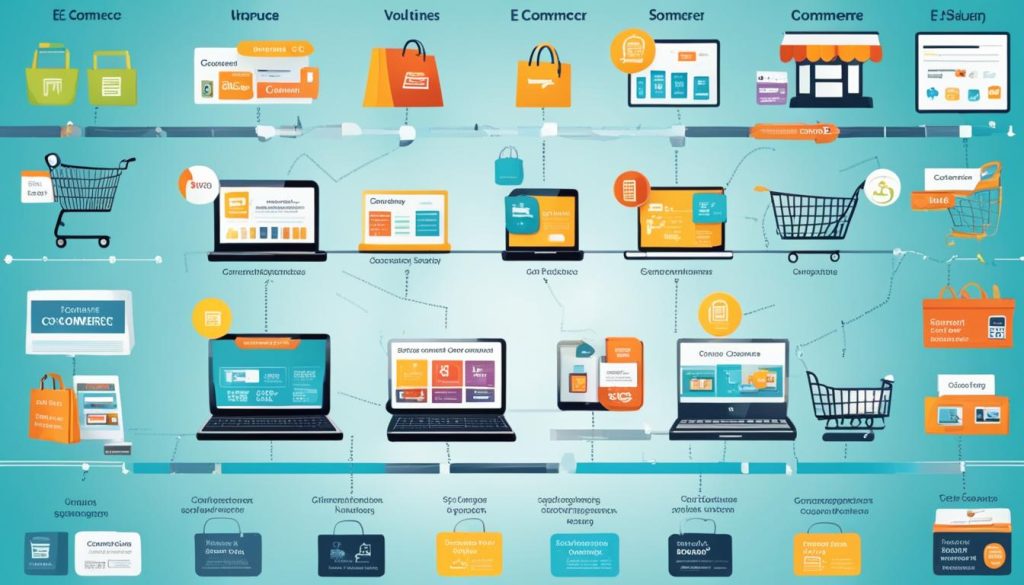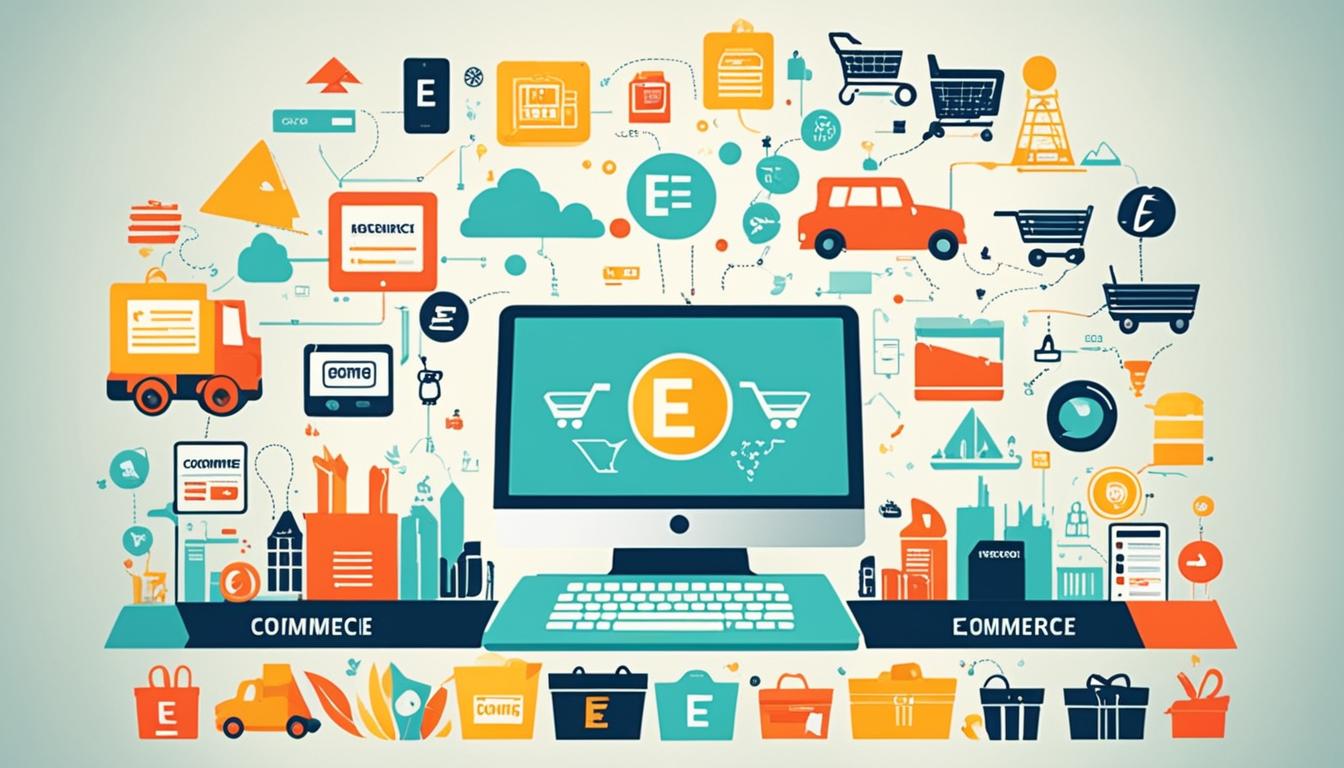Application for e-business
Did you know that e-commerce is growing at an unprecedented rate? With online shopping gaining popularity and advancements in e-commerce app development, businesses are seeking applications to streamline their e-commerce platforms and tap into the vast potential of the digital marketplace.
Key Takeaways:
- E-commerce applications play a vital role in optimizing online business solutions and enhancing the customer experience.
- They provide digital storefronts and efficient e-commerce platform management.
- Applying these applications can automate processes, improve efficiency, and increase sales.
- There are various types of e-commerce applications available, catering to different aspects of e-business, such as retail, accounting, production, trade, advertising, and more.
- By utilizing e-commerce applications, businesses can expand their market reach and stay ahead of the competition in the rapidly evolving e-commerce landscape.
Now, let’s delve into the world of e-commerce applications, explore their benefits, and discover how they can transform your online ventures.
What are E-commerce Applications?
E-commerce applications are versatile tools that serve as a marketing medium for various industries, including retail, wholesale, auctioning, e-banking, and booking. They allow businesses to connect with customers and conduct transactions seamlessly and efficiently in the digital realm. Additionally, e-commerce applications encompass software programs like Amazon or eBay that facilitate online transactions, providing users with a convenient shopping experience.
These applications can be web-based or mobile, catering to users’ preferences and ensuring accessibility across devices. Through e-commerce applications, businesses can leverage the power of technology to expand their market reach, boost sales, and enhance customer engagement.
| Benefits of E-commerce Applications: |
|---|
| 1. Streamline operations |
| 2. Increase sales |
| 3. Expand market reach |
| 4. Enhance customer experience |
| 5. Automate processes |
| 6. Improve efficiency |
Popular E-commerce Applications
E-commerce applications are utilized across various industries and functions, catering to a wide range of needs. Here are some popular applications that have made a significant impact:
Retail E-commerce
Retail e-commerce applications have transformed the way customers shop, providing a convenient platform for online purchases and delivery services.
Accounting Tools for Financial Transactions
Accounting applications streamline financial processes, allowing businesses to manage transactions, track expenses, and generate reports efficiently.
Production Management Systems
Production management applications help businesses streamline their manufacturing processes, optimize inventory management, and ensure efficient supply chain operations.
Trade Platforms
Trade platforms transcend geographical boundaries, providing businesses with opportunities for international trade, market expansion, and global networking.
Advertising Platforms for Marketing Strategies
Advertising applications enable businesses to create and manage online marketing campaigns, target specific audience segments, and track advertising performance.
Digital Shopping Applications
Digital shopping applications provide users with a seamless shopping experience, offering a wide range of products and services with convenient payment options.
Web and Mobile Applications for Seamless Shopping Experiences
Web and mobile applications enhance the convenience of online shopping, allowing users to browse and purchase products anytime and anywhere.
Digital Reservations for Travel and Tourism
Digital reservation applications simplify the process of booking flights, hotels, tours, and other travel-related services, making travel planning more accessible and efficient.
Digital Media Platforms for E-books and Digital Publications
Digital media applications provide a platform for authors, publishers, and readers to publish, purchase, and consume digital content such as e-books, articles, and magazines.
Internet Banking Applications
Internet banking applications enable users to perform financial transactions, manage accounts, and access banking services conveniently and securely online.
These popular e-commerce applications cater to diverse industries and have revolutionized the way businesses operate in the digital world. With their efficiency and convenience, they continue to drive the growth of e-commerce across various sectors.
E-commerce Application Models
E-commerce applications play a vital role in facilitating various types of transactions between businesses, consumers, and government agencies. These applications can be categorized into different models based on the nature of the transactions they enable. Let’s explore the different e-commerce application models:
1. Business-to-Business (B2B)
- Definition: B2B e-commerce involves transactions between two or more businesses.
- Example: Wholesale suppliers providing products to retailers or manufacturers sourcing raw materials from suppliers.
- Benefits: B2B e-commerce streamlines procurement processes, enables bulk purchases, and fosters efficient supply chain management.
2. Business-to-Consumer (B2C)
- Definition: B2C e-commerce involves transactions between businesses and individual consumers.
- Example: Online retailers selling products directly to consumers, such as Amazon or Walmart.
- Benefits: B2C e-commerce provides convenience, a wide product range, and personalized shopping experiences for consumers.
3. Consumer-to-Consumer (C2C)
- Definition: C2C e-commerce involves transactions between individual consumers.
- Example: Online marketplace platforms like eBay, where individuals can buy and sell products to each other.
- Benefits: C2C e-commerce offers a platform for individuals to engage in peer-to-peer transactions and monetize their possessions.
4. Consumer-to-Business (C2B)
- Definition: C2B e-commerce involves transactions where individual consumers offer products or services to businesses.
- Example: Freelancers providing services or content creators licensing their work to businesses.
- Benefits: C2B e-commerce allows businesses to tap into a diverse pool of talent, expertise, and creativity.
5. Business-to-Administration (B2A)
- Definition: B2A e-commerce involves transactions between businesses and government agencies.
- Example: Businesses filing tax returns or submitting regulatory documents online.
- Benefits: B2A e-commerce streamlines administrative processes, reduces paperwork, and enhances government services.
6. Consumer-to-Administration (C2A)
- Definition: C2A e-commerce involves transactions between individual consumers and government agencies.
- Example: Citizens paying taxes or renewing licenses through online government portals.
- Benefits: C2A e-commerce simplifies administrative tasks, provides easy access to government services, and reduces physical visits and waiting times.
These various e-commerce application models cater to different transactional needs and play a crucial role in shaping the modern digital economy. Understanding these models can help businesses and consumers choose the right e-commerce platform to meet their specific requirements.

Evolution of E-commerce Applications
E-commerce applications have come a long way in meeting the evolving demands of the market and consumers. To develop successful e-commerce applications, it is crucial to consider market prerequisites, customer segmentation, industry trends, customer behavior, and competition analysis. Understanding these factors allows businesses to create applications that cater to their target audience’s preferences and effectively compete in the ever-growing e-commerce market.
Market prerequisites play a fundamental role in shaping the features and functionalities of e-commerce applications. What the market demands in terms of convenience, personalization, and security heavily influences the development process. By addressing these prerequisites, businesses can ensure that their applications align with market expectations and meet customer needs.
Customer segmentation is another critical factor to consider when developing e-commerce applications. By analyzing customer behavior and preferences, businesses can create targeted experiences that resonate with their specific customer segments. This targeted approach allows for personalized product recommendations, tailored promotions, and an overall enhanced customer experience, leading to higher conversion rates and customer satisfaction.
Industry trends also significantly impact the development of e-commerce applications. Staying informed about the latest trends in the e-commerce market enables businesses to proactively adopt new technologies, functionalities, and design principles. By keeping up with industry trends, businesses can ensure that their applications remain competitive and offer innovative features that meet or exceed customer expectations.
Understanding customer behavior is a crucial aspect of developing successful e-commerce applications. By analyzing customer interactions, preferences, and purchasing patterns, businesses can design applications that facilitate a seamless and enjoyable shopping experience. This includes optimizing product search functionalities, reducing friction in the checkout process, and providing personalized recommendations throughout the customer journey.
In addition to customer behavior, conducting thorough competition analysis is essential for developing competitive e-commerce applications. By studying competitors’ strengths, weaknesses, and strategies, businesses can identify opportunities to differentiate themselves in the market. This analysis helps inform decisions regarding unique selling propositions, pricing strategies, marketing approaches, and user experience enhancements.
By taking into account market prerequisites, customer segmentation, industry trends, customer behavior, and competition analysis, businesses can develop e-commerce applications that stand out in the competitive market. This strategic approach ensures that the applications meet customers’ needs, provide exceptional user experiences, and drive business growth in the ever-evolving e-commerce landscape.

How to Create an E-commerce App
To create a successful e-commerce app, there are several key steps to follow. Let’s explore the process from start to finish:
- Define your business idea: Start by identifying your unique business idea, whether it’s selling a specific product or offering a specialized service. Having a clear vision will guide your app development process.
- Identify your target audience: Understand who your potential customers are and what their needs and preferences are. Conduct market research to gather insights and tailor your app to cater to your target audience.
- Learn from top e-commerce sites: Study successful e-commerce platforms to learn about industry best practices and key features. Analyze top e-commerce sites such as Amazon, eBay, and Shopify to gain inspiration for your own app.
- Choose a website name, domain, and hosting: Select a memorable and relevant website name that reflects your brand. Register a domain name and choose a reliable hosting provider to ensure your app is accessible to users.
- Select the right platform: Choose an e-commerce platform that suits your business needs and budget. Popular options include WooCommerce, Magento, and Shopify. Consider factors such as ease of use, scalability, and available features.
- Customize a prebuilt e-commerce web template: Save development time and effort by customizing a prebuilt e-commerce web template. Personalize the design and layout to align with your brand identity and create a visually appealing app.
- Add products and create compelling descriptions: Populate your app with your products or services. Ensure each item is accompanied by a clear and compelling description, highlighting its unique features and benefits.
- Set up payment options: Integrate secure and convenient payment options for your customers. Popular choices include credit/debit card processing, PayPal, Apple Pay, and Google Pay.
- Include contact information: Make it easy for customers to reach you by providing clear contact information. Include a dedicated contact page with a contact form and display your email address and phone number prominently.
- Implement shipping mechanisms: Set up shipping options based on your business model. Offer various shipping methods like standard, express, or international shipping. Calculate shipping costs accurately and provide tracking information to customers.
- Test and deploy your app: Before launching your app, perform thorough testing to ensure all features are working smoothly. Check for any bugs or glitches and optimize the app for different devices and browsers. Once ready, deploy your app to make it live.
- Market and promote your app: Develop a comprehensive marketing and promotion strategy to attract customers to your app. Utilize social media, targeted advertising, content marketing, and influencer partnerships to increase app visibility and drive sales.
By following these steps, you can create a compelling and user-friendly e-commerce app that resonates with your target audience and drives business growth.
Benefits of E-commerce Applications
E-commerce applications offer a range of benefits that can significantly impact businesses in today’s digital landscape. These applications streamline operations, enhance customer experience, automate processes, and improve efficiency, ultimately driving growth and success.
Streamline Operations
By utilizing e-commerce applications, businesses can streamline various aspects of their operations. These applications simplify inventory management, making it easier to track and update stock levels. They also streamline order processing, allowing businesses to efficiently handle customer orders and streamline the fulfillment process.
Expand Market Reach
E-commerce applications enable businesses to expand their market reach beyond their physical locations. With these applications, companies can easily sell their products and services to customers across different geographical regions. This expands the customer base and increases the potential for sales growth.
Enhance Customer Experience
E-commerce applications provide a seamless and convenient shopping experience for customers. These applications offer user-friendly interfaces, easy navigation, and personalized product recommendations, enhancing customer satisfaction. By delivering a positive shopping experience, businesses can build customer loyalty and drive repeat purchases.
Automate Processes
E-commerce applications automate various processes, reducing the need for manual intervention and streamlining workflows. These applications automate tasks such as order processing, payment handling, and inventory management, saving businesses time and resources. By automating processes, businesses can focus on core activities and improve overall operational efficiency.
Improve Efficiency
E-commerce applications improve the overall efficiency of businesses. With streamlined operations, automated processes, and integrated systems, businesses can optimize their workflows and eliminate manual errors. This improves productivity and allows businesses to allocate resources more effectively, ultimately leading to improved efficiency and reduced costs.
Conclusion
E-commerce applications have completely transformed the way businesses operate in the digital era. With their wide range of tools and functionalities, these applications provide online business solutions, digital storefronts, and efficient e-commerce platform management. By leveraging the power of e-commerce applications, businesses can optimize their online ventures and stay ahead of the competition in the rapidly evolving e-commerce landscape.
Whether you’re in the retail, finance, production, or any other industry, e-commerce applications offer the perfect solution to streamline your business operations and drive growth. From managing inventory and processing orders to tracking sales and expanding market reach, these applications can revolutionize your online presence. With a user-friendly interface and seamless integration, you can create a digital storefront that enhances the customer experience and maximizes sales potential.
Furthermore, e-commerce applications automate key processes, saving you time and resources. With features like efficient payment options, contact information management, and smooth shipping mechanisms, these applications make it easier than ever to run a successful online business. By utilizing advanced analytics and reporting, you can gain valuable insights into customer behavior and market trends, allowing you to make informed decisions and adapt your strategies to meet changing demands.
In conclusion, the power of e-commerce applications cannot be underestimated. They provide businesses with the necessary tools to establish a strong online presence, streamline operations, and maximize sales potential. Whether you’re just starting out or looking to expand your existing online business, incorporating e-commerce applications into your strategy is the key to success in the digital marketplace.
FAQ
What is an e-commerce application?
What are some popular e-commerce applications?
What are the different models of e-commerce applications?
How have e-commerce applications evolved over time?
How can I create an e-commerce app?
What are the benefits of e-commerce applications?
- How Strategic SEO Drove Growth for a CPAP E-commerce Brand - July 24, 2025
- Top 3 SEO Companies in Toronto: An Analytical Comparison - July 23, 2025
- SEO for Entry Door Services - April 24, 2025





















Post Comment
You must be logged in to post a comment.